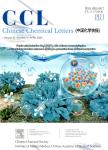Influence of donor:acceptor ratio on charge transfer dynamics in non-fullerene organic bulk heterojunctions
Influence of donor:acceptor ratio on charge transfer dynamics in non-fullerene organic bulk heterojunctions作者机构:School of PhysicsState Key Laboratory of Crystal MaterialsShandong UniversityJi’nan 250100China School of PhysicsHenan Normal UniversityXinxiang 453000China Center of Nanoelectronics and School of MicroelectronicsShandong UniversityJi’nan 250100China ARC Centre of Excellence in Exciton ScienceSchool of ChemistryThe University of MelbourneParkvilleVictoria 3010Australia
出 版 物:《Chinese Chemical Letters》 (中国化学快报(英文版))
年 卷 期:2021年第32卷第1期
页 面:529-534页
核心收录:
学科分类:08[工学] 080501[工学-材料物理与化学] 080502[工学-材料学] 0805[工学-材料科学与工程(可授工学、理学学位)]
基 金:supported by the National Natural Science Foundation of China(Nos.11774204,11804084) Major Program of Natural Science Foundation 25 of Shandong Province(No.ZR2019ZD43) the Fundamental Research Funds of Shandong University(No.2018JC034) support from the ARC Centre of Excellence in Exciton Science(No.CE170100026) the Shanghai Synchrotron Radiation Facility(beamline BL16B1)for providing the beam time for GIWAXS measurements
主 题:Donor:acceptor ratio Charge transfer dynamics Non-fullerene Organic bulk heterojunctions Organic solar cells
摘 要:The donor:acceptor(D:A) blend ratio plays a very important role in affecting the progress of charge transfer and energy transfer in bulk heterojunction(BHJ) orga nic solar cells(OSCs).The proper D:A blend ratio can provide maximized D/A interfacial area for exciton dissociation and appro p riate domain size of the exciton diffusion length,which is beneficial to obtain high-performance ***,we comprehensively investigated the relationship between various D:A blend ratios and the charge transfer and energy transfer mechanisms in OSCs based on PBDB-T and non-fullerene acceptor *** on various D:A blend ratios,it was found that the ratio of components is a key factor to suppress the formation of triplet states and recombination energy *** D:A blend ratios can provide appropriate donor/accepter surface for charge transfer which has been powerfully verified by various detailed experimental results from the time-resolved fluorescence measurement and transient absorption(TA) *** coherence length and crystallinity are verified by grazing incident wide-angle X-ray scattering(GIWAXS) *** results are bene ficial to comprehend the effects of various D:A blend ratios on charge transfer and energy transfer dynamics and provides constructive suggestions for rationally designing new materials and feedback for photovoltaic performance optimization in non-fullerene OSCs.



